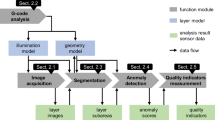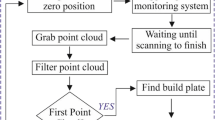Abstract
This work presents a novel methodology for the quality assessment of material extrusion parts through AI-based Computer Vision. To this end, different techniques are integrated using inspection methods that are applied to other areas in additive manufacturing field. The system is divided into four main points: (1) pre-processing, (2) color analysis, (3) shape analysis, and (4) defect location. The color analysis is performed in CIELAB color space, and the color distance between the part under analysis and the reference surface is calculated using the color difference formula CIE2000. The shape analysis consists of the binarization of the image using the Canny edge detector. Then, the Hu moments are calculated for images from the part under analysis and the results are compared with those from the reference part. To locate defects, the image of the part to be analyzed is first processed with a median filter, and both the original and filtered image are subtracted. Then, the resulting image is binarized, and the defects are located through a blob detector. In the training phase, a subset of parts was used to evaluate the performance of different methods and to set the values of parameters. Later, in a testing and validation phase, the performance of the system was evaluated using a different set of parts. The results show that the proposed system is able to classify parts produced by additive manufacturing, with an overall accuracy of 86.5%, and to locate defects on their surfaces in a more effective manner.














Similar content being viewed by others
Change history
13 January 2023
Springer Nature’s version of this paper was updated to present the correct ORCID of the corresponding author.
References
ISO/ASTM52900-15 (2015) Standard terminology for additive manufacturing – general principles – terminology, West Conshohocken, PA, American Society for Testing and Materials
Shen H, Pan L, Qian J (2019) Research on large-scale additive manufacturing based on multi-robot collaboration technology. Addit Manuf 30:100906
Paolini A, Kollmannsberger S, Rank E (2019) Additive manufacturing in construction: a review on processes, applications, and digital planning methods. Addit Manuf 30:100894
Casavola C, Cazzato A, Moramarco V, Pappalettere C (2016) Orthotropic mechanical properties of fused deposition modelling parts described by classical laminate theory. Mater Des 90:453–458
Leite M, Varanda A, Ribeiro AR, Silva A, Vaz MF (2018) Mechanical properties and water absorption of surface modified ABS 3D printed by fused deposition modelling. Rapid Prototyp J 24(1):195–203
de Macedo RQ, Ferreira RTL, Jayachandran K (2019) Determination of mechanical properties of FFF 3D printed material by assessing void volume fraction, cooling rate and residual thermal stresses. Rapid Prototyp J 25(10):1661–1683
Gleadall A, Ashcroft I, Segal J (2018) VOLCO: a predictive model for 3D printed microarchitecture. Addit Manuf 21:605–618
de Macedo RQ, Ferreira RTL, Gleadall A, Ashcroft I (2021) Volco-x: Numerical simulation of material distribution and voids in extrusion additive manufacturing. Addit Manuf 40:101900
Guo N, Leu MC (2013) Additive manufacturing: technology, applications and research needs. Front Mech Eng 8(3):215–243
RB Kristiawan, F Imaduddin, D Ariawan, Ubaidillah, and Z Arifin (2021) A review on the fused deposition modeling (fdm) 3d printing: filament processing, materials, and printing parameters. Open Engineering 11:639 – 649
Ngo TD, Kashani A, Imbalzano G, Nguyen KTQ, Hui D (2018) Additive manufacturing (3d printing): a review of materials, methods, applications and challenges. Compos Part B: Eng 143:172–196
Dutra TA, Ferreira RTL, Resende HB, Blinzler BJ, Larsson R (2020) Expanding Puck and Schürmann inter fiber fracture criterion for fiber reinforced thermoplastic 3D-printed composite materials. Mater 13(7):1653
Tekinalp HL, Kunc V, Velez-Garcia GM, Duty CE, Love LJ, Naskar AK, Blue CA, Ozcan S (2014) Highly oriented carbon fiber-polymer composites via additive manufacturing. Compos Sci Technol 105:144–150
Ning F, Cong W, Qiu J, Wei J, Wang S (2015) Additive manufacturing of carbon fiber reinforced thermoplastic composites using fused deposition modeling. Compos B Eng 80:369–378
Ning F, Cong W, Yingbin Hu, Wang H (2017) Additive manufacturing of carbon fiber-reinforced plastic composites using fused deposition modeling: effects of process parameters on tensile properties. J Compos Mater 51(4):451–462
Luiz Ferreira RT, Amatte IC, Dutra TA, Bürger D (2017) Experimental characterization and micrography of 3d printed pla and pla reinforced with short carbon fibers. Compos Part B: Eng 124:88–100
Araya-Calvo M, López-Gómez I, ChamberlainSimon N, León-Salazar JL, Guillén-Girón T, Corrales-Cordero JS, Sánchez-Brenes O (2018) Evaluation of compressive and flexural properties of continuous fiber fabrication additive manufacturing technology. Addit Manuf 22:157–164
Blok LG, Longana ML, Yu H, Woods BKS (2018) An investigation into 3D printing of fibre reinforced thermoplastic composites. Addit Manuf 22:176–186
Dickson AN, Barry JN, McDonnell KA, Dowling DP (2017) Fabrication of continuous carbon, glass and Kevlar fibre reinforced polymer composites using additive manufacturing. Addit Manuf 16:146–152
Dutra TA, Ferreira RT, Resende HB, Guimarães A (2019) Mechanical characterization and asymptotic homogenization of 3D-printed continuous carbon fiberreinforced thermoplastic. J Braz Soc Mech Sci Eng 41(3):133
Kikuchi BC et al (2020) Moisture effect on the mechanical properties of additively manufactured continuous carbon fiber-reinforced nylon-based thermoplastic. Polym Compos 41(12):5227–5245
Weiller M Lamin, Flávio LS Bussamra, Rafael TL Ferreira, Rita CM Sales, and José E Baldo Jr (2021) Linear translaminar fracture characterization of additive manufactured continuous carbon fiber reinforced thermoplastic. Journal of Thermoplastic Composite Materials
Dutra TA, Ferreira RTL, Resende HB, Blinzler BJ, Asp LE (2021) Mechanism based failure of 3d-printed continuous carbon fiber reinforced thermoplastic composites. Compos Sci Technol 213:108962
Dutra TA, Ferreira RTL, Resende HB, Oliveira LM, Blinzler BJ, Asp LE (2022) Identification of representative equivalent volumes on the microstructure of 3d-printed fiber-reinforced thermoplastics based on statistical characterization. Polymers 14(5):972
Charalampous P, Kostavelis I, Kopsacheilis C, Tzovaras D (2021) Vision-based real-time monitoring of extrusion additive manufacturing processes for automatic manufacturing error detection. Int J Adv Manuf Technol 115:08
Malamas EN, Petrakis EGM, Zervakis M, Petit L, Legat JD (2003) A survey on industrial vision systems, applications and tools. Image Vis Comput 21(2):171–188
Straub J (2015) Initial work on the characterization of additive manufacturing (3d printing) using software image analysis. Mach 3:55–71
Nuchitprasitchai S, Roggemann M, Pearce J (2017) Factors effecting real-time optical monitoring of fused filament 3d printing. Prog Addit Manuf 2:09
Petsiuk AL, Pearce JM (2020) Open source computer vision-based layer-wise 3d printing analysis. Addit Manuf 36:101473
Fu Y, Downey A, Yuan L, Pratt A, Balogun Y (2021) In situ monitoring for fused filament fabrication process: a review. Addit Manuf 38:101749
Moretti M, Rossi A, Senin N (2021) In-process monitoring of part geometry in fused filament fabrication using computer vision and digital twins. Addit Manuf 37:101609
Li L, McGuan R, Isaac R, Kavehpour P, Candler R (2021) Improving precision of material extrusion 3d printing by in-situ monitoring & predicting 3d geometric deviation using conditional adversarial networks. Addit Manuf 38:101695
Cannizzaro D, Varrella AG, Paradiso S, Sampieri R, Chen Y, Macii A, Patti E, Di Cataldo S (2021) In-situ defect detection of metal additive manfacturing: an integrated framework. IEEE Trans Emerg Top Comput 10(1):74–86
Jiang XY, Sun XY, Wang S, Wang R (2012) Intelligent process quality control system for mass customization. J. Softw. 7:804–809
Zhao F, He Z, Wu D (2008) Quality assurance of mass customization: a state-of-the-art review. 1–3. https://doi.org/10.1109/AMIGE.2008.ECP.75
Zhang C, Xuewu X, Fan C, Wang G (2021) Literature review of machine vision in application field. E3S Web Conf 236:04027
T Benbarrad SB Kenitar M Arioua (2020) Intelligent machine vision model for defective product inspection based on machine learning In 2020 Int Symp Adv Electr Commun Technol (ISAECT) 1 6
Qazi I-U-H, Alata O, Burie J-C, Moussa A, Fernandez-Maloigne C (2011) Choice of a pertinent color space for color texture characterization using parametric spectral analysis. Pattern Recogn 44(1):16–31
Waskale H, Bhong M (2017) Experimental RGB and CIE lab colour space analysis and comparison for fruits and vegetables. J Emerg Technol Innov Res 4:1–4
Mokrzycki W, Tatol M (2011) Color difference delta e a survey. Mach Graphics Vis 20(4):383–411
Pereira A, Carvalho P, Coelho G, Côrte-Real L (2020) Efficient ciede2000-based color similarity decision for computer vision. IEEE Trans Circuits Syst Video Technol 30(7):2141–2154
Zhang D, Guojun Lu (2004) Review of shape representation and description techniques. Pattern Recogn 37(1):1–19
Ming-Kuei Hu (1962) Visual pattern recognition by moment invariants. IRE Trans Inf Theory 8(2):179–187
Huang Z, Leng J (2010) Analysis of hu’s moment invariants on image scaling and rotation. In 2010 2nd Int Conf Comput Eng Technol 7:7–476
Chen WJ, Ho J-H, Mustapha KB, Chai T-Y (2019) A vision based system for anomaly detection and classification in additive manufacturing. 2019 IEEE conference on sustainable utilization and development in engineering and technologies (CSUDET), pp 87–92. https://doi.org/10.1109/CSUDET47057.2019.9214635
Mu H, Qi D (2009) Pattern recognition of wood defects types based on Hu invariant moments. 2009 2nd international congress on image and signal processing, pp 1–5. https://doi.org/10.1109/CISP.2009.5303866
Fujita Y, Hamamoto Y (2011) A robust automatic crack detection method from noisy concrete surfaces. Mach Vis Appl 22(2):245–254
Hoang ND, Nguyen QL (2019) A novel method for asphalt pavement crack classification based on image processing and machine learning. Eng Comput 35(2):487–498
Albarzinji S (2014) An efficient approach for improving canny edge detection algorithm. Int J Adv Eng Technol 7(1):59
M Huang, W Yu, and D Zhu (2012) An improved image segmentation algorithm based on the otsu method. In 2012 13th ACIS International Conference on Software Engineering, Artificial Intelligence, Networking and Parallel/Distributed Computing 135–139
Open Source Computer Vision. Opencv: open source computer vision library: color conversions. https://docs.opencv.org/3.4/de/d25/ imgproc_color_conversions.html. Accessed:2021–07–08.
T Fawcett (2006) An introduction to ROC analysis. Pattern Recognition Letters, 27(8):861–874. ROC Analysis in Pattern Recognition
Okarma K, Fastowicz J (2020) Improved quality assessment of colour surfaces for additive manufacturing based on image entropy. Pattern Anal Appl 23:08
Acknowledgements
The author Rui Pedro Castro Nascimento acknowledges the INEGI Institute of Science and Innovation in Mechanical and Industrial Engineering.
Funding
This work was developed under the R&DT Project – InSoleTech POCI01-0247-FEDER-038470, co-financed by the Competitiveness and Internationalization Operational Program (POCI), through Portugal 2020 and the European Regional Development Fund (FEDER).
Author information
Authors and Affiliations
Contributions
Rui Pedro Castro Nascimento: Conceptualization, Methodology, Software, Writing Original Draft, Investigation, Formal analysis. Maria Isabel Martins: Conceptualization, Methodology, Validation, Supervision, Project administration, Writing Review and Editing. Thiago Assis Dutra: Validation, Writing Original Draft. Luís Carlos Moreira: Supervision, Funding acquisition.
Corresponding author
Ethics declarations
Competing interests
The authors declare no competing interests.
Additional information
Publisher's note
Springer Nature remains neutral with regard to jurisdictional claims in published maps and institutional affiliations.
Rights and permissions
Springer Nature or its licensor (e.g. a society or other partner) holds exclusive rights to this article under a publishing agreement with the author(s) or other rightsholder(s); author self-archiving of the accepted manuscript version of this article is solely governed by the terms of such publishing agreement and applicable law.
About this article
Cite this article
Nascimento, R., Martins, I., Dutra, T.A. et al. Computer Vision Based Quality Control for Additive Manufacturing Parts. Int J Adv Manuf Technol 124, 3241–3256 (2023). https://doi.org/10.1007/s00170-022-10683-5
Received:
Accepted:
Published:
Issue Date:
DOI: https://doi.org/10.1007/s00170-022-10683-5




